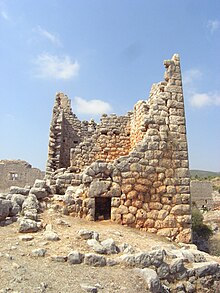Kanytelleis
Kanytelleis (also Kanytellis, Kanytelis, Kanytella, later Neopolis, now Kanlıdivane ) is an ancient city in Cilicia . It is located on the Turkish south coast between Silifke and Erdemli , about eight kilometers east of Kızkalesi , the ancient Korykos in the province of Mersin .
Coordinates: 36 ° 31 ′ 32 " N , 34 ° 10 ′ 46" E
history
The founding date of the city is not known, but an inscription by Teukros from Olba found on site suggests that the city was in the second century BC. Belonged to the priestly state of Olba-Diokaisareia, about 30 km northwest. This is also indicated by the triskelis in relief on the tower as an olbic symbol . From other inscriptions we can read that the place later belonged to Elaiussa Sebaste . During the reign of the Eastern Roman Emperor Theodosius II in the fifth century AD, it was expanded and renamed Neopolis. The city was probably abandoned in the 11th century.
The French orientalist Victor Langlois visited Kanytelleis in the mid-19th century and identified it as the Byzantine Neopolis. The first investigations were carried out in the 1970s under the direction of Semavi Eyice . In 2006 Hatice Pamir from Mustafa Kemal University in Antakya started a survey .
Relics
The relics of the city are grouped around a collapse doline 70 m in diameter and 60 m deep, similar to the two karst falls of the nearby Koryk grottos . In the sinkhole, which is accessible via a beaten path, there are two reliefs in the walls, on the south side an image of six members of the Armaronxas family, about whom nothing is known, and on the north side a portrait of a Roman warrior.
Hellenistic tower
The only evidence from pre-Christian times is a former three-story Hellenistic defense and residential tower made of polygonal masonry with the aforementioned Olbic symbol on the southern edge of the sinkhole . A dedicatory inscription for Zeus Olbios points to the second century BC. Chr.
Basilica 1
In the southwest of the sinkhole is the largely preserved Byzantine basilica 1, a three-nave columned basilica with a length of 31 meters and a width of 18.40 meters. A three-part arched opening leads into the narthex in the west, the capitals of which are decorated with large-lobed acanthus leaves. The largely preserved wall to the church interior is pierced in the middle by a rectangular portal. The apse opens a twin window with horseshoe arches to the east. Two -storey pastophoria are built next to the apse , so that a straight choir closure is created on the outside .
If you go around the sinkhole in a clockwise direction, the poorly preserved basilicas 2 and 3 follow in the west and north-west.
Papylos Church
According to a donor inscription, the three-aisled basilica in the northeast of the sinkhole is called 4 Papylos Church . It was built at the end of the fifth century and is the youngest and best preserved basilica in Kanytelleis. Most of the walls are still up to 8 meters high. Only the south wall has completely broken away. To the west of the basilica is a forecourt 15 meters wide and around 10 meters deep. Half an arch still stands from a three-part, open arch position, the western entrance into the 3.60 meter deep and 14 meter wide narthex. The approximately 22-meter-long church space is divided by two arcades into two narrow aisles and a 6.20-meter-wide central nave, each with a door to the narthex. In the north wall, protruding stone supports indicate the position of the side gallery. The passage from the central nave to the choir was vaulted by a high triumphal arch, of which the left approach can still be seen. The apse with twin windows faces a straight end of the choir.
To the west of the center there are also sparse remains of residential buildings and a cemetery from the Turkish era. There are several extensive necropolises in the north and west of the town . A burial house, sarcophagi and rock graves with reliefs are worth mentioning . In the area there are scattered remains of several aqueducts that supplied Kanytelleis, Elaiussa-Sebaste and Korykos with water.
Individual evidence
- ↑ Homepage Kizkalesi ( Memento from April 10, 2008 in the Internet Archive )
- ↑ Current Archeology in Turkey ( Memento from September 1, 2012 in the Internet Archive )
- ↑ Basilica 1, Kanytelis in the archaeological database Arachne
- ↑ Basilica 4, Kanytelis in the archaeological database Arachne
Web links
literature
- Christof Berns : ΣΉΜΑΤΑ Investigations into the grave and memorial buildings of the late Hellenism and the early imperial period in Asia Minor . University of Cologne 1996 PDF
- Semavi Eyice : Kanlidivane (bir önçalişma) . 1977
- Friedrich Hild , Hansgerd Hellenkemper : Kilikien and Isaurien. Tabula Imperii Byzantini Volume 5. Verlag der Österreichischen Akademie der Wissenschaften, Vienna 1990, ISBN 3-7001-1811-2 , pp. 285–286.
- Gabriele Mietke, Stephan Westphalen : Basilica 3 in Kanlıdivane (Kanytelis) in: Istanbuler Mitteilungen Volume 49, 1999 ISBN 3803016401








